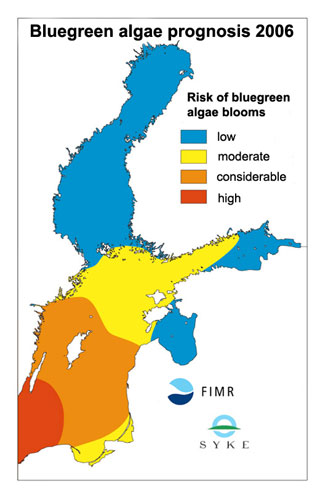Press release
Less intense algal blooms likely this summer in the northern Baltic Sea
 Helsinki, 27 June (HELCOM) – There is some encouraging news for people who will be vacationing this summer especially on the northern shores of the Baltic Sea. The toxic blooms of blue-green algae (or cyanobacteria) are expected to be less intense than usual, although in many places the brownish-green toxic slush will still keep swimmers away from the water.
Helsinki, 27 June (HELCOM) – There is some encouraging news for people who will be vacationing this summer especially on the northern shores of the Baltic Sea. The toxic blooms of blue-green algae (or cyanobacteria) are expected to be less intense than usual, although in many places the brownish-green toxic slush will still keep swimmers away from the water.
According to the study provided to HELCOM by scientists at the Finnish Institute of Marine Research and the Finnish Environment Institute, the blue-green algal blooms are expected to be less intensive this summer than during the previous years. No blooms are expected in the Gulf of Bothnia, eastern Gulf of Finland and in the Gulf of Riga. The risk for blue-green algal blooms is moderate in the western parts of the Gulf of Finland, in the Archipelago Sea, as well as in the northern Baltic Proper. However, risk for blooms increases toward south being high in the southern Baltic Sea.
Intense blue-green algal growth is directly linked to high phosphorus concentrations in surface waters. Warm, calm and sunny weather during early July 2005, in combination with the available phosphate, resulted in a widespread and intense bloom. High levels of phosphorus were measured in the southern Baltic Sea during this year's winter and spring. The main reason for the high levels in the main basin of the Baltic Sea was the phosphorus which is released from the bottom of the sea when the oxygen situation is poor. Autumn and winter storms mix the water column and transport phosphorus into the surface layer, where it is in the reach of algae. In the northern Baltic Sea the phosphorus concentrations have been lower than during the previous years.
Blooms are expected to peak in late July, although since the early summer is warm and calm, they can occur in mid-July. The summer weather will finally determine whether algal blooms will occur in widespread mats or not.
The estimated risk of algal blooms is based on forecasts done by using ecosystem modelling, with the winter nutrient situation as a starting point. The development of the nutrient situation during the spring is also taken into account. The bloom forecast describes the risk of late summer blooms by surface mat forming blue-green algae during average weather and sea current conditions.
During favourable weather conditions, strong algal blooms may occur in a wider area than that described on the map, and if they rise to the surface, they may drift to the Finnish coast with the currents. On the other hand, if the summer is cold and windy, blue-green algae will mix with the surface layer and thus, algal bloom surface mats will remain rare.
Last year, the algal bloom, which covered vast areas, stretching from the Gulf of Finland to the German coast, was one of the worst ever in the history of the Baltic Sea. Floating microscopic algae bloomed extensively, once more providing visible evidence of one of the region’s major problems – eutrophication caused by excessive nutrient loads coming especially from agriculture and municipal wastewaters.
Despite various water protection measures, phosphorus discharges have only been slightly reduced in many Baltic Sea coastal countries. The intensive use of fertilisers over a long period has widely saturated soils with phosphorus, and progress in reducing phosphorus loads will only be visible after a long time lag. Furthermore, in most years, the gradually accumulating phosphorus is tightly bound up in sea-floor sediments by oxygen. In anoxic conditions, however, high amounts of phosphorus are released from the sediment into the sea water – as it happened in 2005, as well as in 2002.
For more information, please contact:
Finnish Institute of Marine Research
Tapani Stipa, scientist, tel.: +358 (09) 6139 4445, e-mail: tapani.stipa@fimr.fi
Seppo Kaitala, algae situation reports co-ordinator, tel.: +358 (09) 6139 4417, 0400 609 269, e-mail: seppo.kaitala@fimr.fi
Finnish Environment Institute
Heikki Pitkänen, senior scientist, tel.: +358 (09)4030 0229, 040 582 3182, e-mail: heikki.pitkanen@ymparisto.fi
HELCOM Secretariat
Juha-Markku Leppänen, professional secretary, tel.: +358 (0)207 412 627, e-mail: juha-markku.leppanen@helcom.fi
Nikolay Vlasov, information secretary, tel.: +358 (0)207 412 635, e-mail: nikolay.vlasov@helcom.fi

